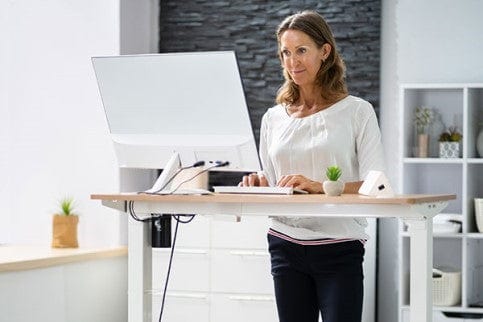
Standing Desk Ergonomics for Home Office Setups
Dickson LamShare
With the digitization of many professions, North Americans are spending more time than ever in front of their computer screens. For those who have embraced the benefits of standing desks, creating an ergonomic setup is essential for maximizing productivity and well-being. Establishing an ergonomic workspace, with proper keyboard and mouse placement to maintain a neutral wrist posture, is crucial for comfort and injury prevention.
At EffyDesk, we are committed to bringing our customers top-quality electric standing desks along with the information they need to curate the perfect work environment. Continue reading as we explore the key elements of mastering ergonomics for standing desk setups, guided by the principles of office ergonomics to ensure comfort and efficiency.

Introduction to Ergonomic Workstations
Creating an ergonomic workstation is essential for anyone looking to boost comfort, productivity, and overall well-being during long hours at the computer. An ergonomic workstation is thoughtfully designed to help you maintain proper posture and reduce strain on your body. This means choosing a standing desk or a height-adjustable desk that allows you to easily switch between sitting and standing, and pairing it with an ergonomic chair that supports your back and encourages your shoulders to stay relaxed.
Proper positioning of your monitor, keyboard, and mouse is also key. Adjust your desk height so your feet rest flat on the floor and your body feels balanced, whether you’re sitting or standing. By using a sit-stand desk, you can alternate your position throughout the day, which helps reduce the risk of musculoskeletal disorders and keeps your circulation flowing. With a few mindful adjustments, your ergonomic workstation can make a significant difference in your comfort and health at work.

Sit-Stand Desk Benefits
Sit-stand desks are more than just a trend. They’re a proven way to enhance your workspace and support your health. By allowing you to alternate between sitting and standing, sit stand desks help reduce the risk of heart disease, improve posture, and make your workday more comfortable. Switching positions throughout the day can ease wrist strain, neck pain, and eye strain, all while encouraging you to move more and sit less.
With a sit-stand desk, you can easily adjust the desk height to find your ideal position, whether you’re sitting or standing. This flexibility means your keyboard and mouse are always at a comfortable height, and your monitor stays at eye level, helping you maintain proper ergonomics. Don’t forget to adjust your chair height as well, so your back and legs are fully supported.

The 90-Degree Rule: Arm and Elbow Alignment
Just as the 90-degree rule applies to your desk height, it’s equally important for your arms and elbows. Keep your elbows close to your body, forming a 90-degree angle when typing or using a mouse. To further support proper alignment, use ergonomic keyboards and pay attention to the placement of the number pad to ensure your wrists and arms remain in a neutral position. This minimizes the risk of shoulder and arm strain, promoting a natural and relaxed working position.
Our ergonomic desk accessories at EffyDesk are designed to complement your electric standing desk seamlessly. Additions like our Vegan Leather DeskPad allow for precise adjustments, ensuring that your arms and hands are positioned optimally, reducing the likelihood of repetitive strain injuries. These accessories can enhance comfort and help you experience less stress during long work sessions.

Anti-Fatigue Mats: Supporting Your Feet
Standing for extended periods can lead to fatigue and discomfort in your lower limbs. Leg fatigue is common when standing for long periods, so it’s important to provide proper support to reduce strain and improve circulation. To address this, consider placing an anti-fatigue mat under your electric standing desk. These mats provide cushioning and support, reducing the strain on your feet, knees, and back. When using an anti-fatigue mat, ensure your body remains parallel to the floor to promote proper posture and comfort.
Our anti-fatigue standing mat not only provides comfort but also complements the aesthetic of your workspace. By incorporating these mats into your standing desk setup, you create a more inviting and ergonomic environment.
Monitor Placement: Eye Level is Key
Proper monitor placement is crucial for preventing neck and eye strain. Position your monitor at eye level, ensuring that your gaze falls naturally at the top third of the screen. For optimal comfort, place the monitor about an arm's length away. Make sure your main screen is directly in front of you. If you use two screens, position the primary monitor in front and the secondary monitor to the side to minimize neck movement. This alignment helps maintain a neutral neck position and reduces the risk of developing discomfort over prolonged periods.
EffyDesk’s range of desk monitor mounts allows you to adjust the height, tilt, and rotation of your monitors, offering a customizable solution that complements your ergonomic standing desk. This adaptability not only enhances comfort but also promotes a healthier posture.
Move Freely: Embracing Dynamic Ergonomics
While standing desks offer a healthy alternative to prolonged sitting, it’s essential to incorporate movement into your routine. Our sit-stand desks encourage dynamic ergonomics, allowing you to switch between sitting and standing positions effortlessly. This variation in posture promotes blood circulation, reduces fatigue, and enhances overall well-being.
By practicing alternate sitting and standing throughout the day, you can prevent discomfort and reduce the health risks associated with staying in one position too long. Remember to maintain a spine neutral position during both sitting and standing to support proper alignment and minimize strain.
Shop our selection of standing desks, ergonomic chairs with lumbar support for better back health, and accessories today.
Common Mistakes to Avoid
Even with the best intentions, it’s easy to make mistakes when setting up your ergonomic workstation.
-
Leaning forward can strain your back and neck.
-
Make sure your monitor isn’t too high or too low, and always adjust your chair height so your back and legs are properly supported.
-
If you’re using a laptop, avoid hunching over by using a laptop stand to bring the screen to eye level.
-
Forgetting to take regular breaks or failing to alternate between sitting and standing can lead to musculoskeletal disorders and poor circulation.
By being mindful of these common mistakes and making simple adjustments, you can create an ergonomic setup that keeps you comfortable and reduces the risk of discomfort or injury.
Ergonomic Setup Checklist
To ensure your workspace is as ergonomic as possible, follow this simple checklist:
-
Adjust your desk height so your feet rest flat on the floor
-
Keep your shoulders relaxed and your spine in a neutral position
-
Position your monitor at eye level and an arm’s length away
-
Place your keyboard and mouse at a comfortable height and distance
-
Adjust your chair height to support your back and legs
-
Use a wrist rest to reduce strain on your wrists
-
Take regular breaks to stretch and move around
-
Alternate between sitting and standing every 30-60 minutes
-
Use an anti fatigue mat to reduce strain on your feet and legs
-
Consider a split keyboard and ergonomic mouse to reduce hand and wrist strain
By following this ergonomic setup checklist, you’ll create a workspace that promotes comfort, reduces strain, and supports your overall well-being, helping you stay productive and pain-free throughout your workday.